Calcitriol promotes augmented dopamine release in the lesioned striatum of 6-hydroxydopamine treated rats
- PMID: 24858239
- PMCID: PMC4125437
- DOI: 10.1007/s11064-014-1331-1
Calcitriol promotes augmented dopamine release in the lesioned striatum of 6-hydroxydopamine treated rats
Abstract
Current therapies for Parkinson's disease (PD) offer symptomatic relief but do not provide a cure or slow the disease process. Treatments that could halt progression of the disease or help restore function to damaged neurons would be of substantial benefit. Calcitriol, the active metabolite of vitamin D, has been shown to have significant effects on the brain. These effects include upregulating trophic factor levels, and reducing the severity of some central nervous system lesions. While previous studies have shown that calcitriol can be neuroprotective in 6-hydroxydopamine (6-OHDA) rodent models of PD, the present experiments were designed to examine the ability of calcitriol to promote restoration of extracellular dopamine (DA) levels and tissue content of DA in animals previously lesioned with 6-OHDA. Male Fischer-344 rats were given a single injection of 12 µg 6-OHDA into the right striatum. Four weeks later the animals were administered vehicle or calcitriol (0.3 or 1.0 µg/kg, s.c.) once a day for eight consecutive days. Three weeks after the calcitriol treatments in vivo microdialysis experiments were conducted to measure potassium and amphetamine evoked overflow of DA from both the left and right striata. In control animals treated with 6-OHDA and vehicle there were significant reductions in both potassium and amphetamine evoked overflow of DA on the lesioned side of the brain compared to the contralateral side. In animals treated with 6-OHDA followed by calcitriol there was significantly greater potassium and amphetamine evoked overflow of DA from the lesioned striatum compared to that from the control animals. The calcitriol treatments also led to increases in postmortem tissue levels of DA in the striatum and substantia nigra. These results suggest that calcitriol may help promote recovery of dopaminergic functioning in injured nigrostriatal neurons.
Conflict of interest statement
None of the authors have a conflict of interest of any type in association with this work.
Figures
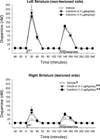
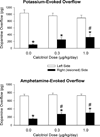
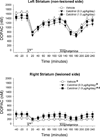
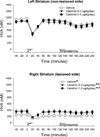
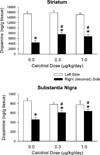
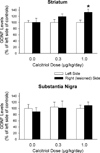
Similar articles
-
Reduced ability of calcitriol to promote augmented dopamine release in the lesioned striatum of aged rats.Neurochem Int. 2017 Sep;108:222-229. doi: 10.1016/j.neuint.2017.04.001. Epub 2017 Apr 5. Neurochem Int. 2017. PMID: 28390950 Free PMC article.
-
Evoked dopamine overflow is augmented in the striatum of calcitriol treated rats.Neurochem Int. 2012 Jan;60(2):186-91. doi: 10.1016/j.neuint.2011.11.010. Epub 2011 Nov 22. Neurochem Int. 2012. PMID: 22133428 Free PMC article.
-
Neurturin protects against 6-hydroxydopamine-induced reductions in evoked dopamine overflow in rat striatum.Neurochem Int. 2010 Nov;57(5):540-6. doi: 10.1016/j.neuint.2010.06.019. Epub 2010 Jul 6. Neurochem Int. 2010. PMID: 20615442 Free PMC article.
-
Effect of AdGDNF on dopaminergic neurotransmission in the striatum of 6-OHDA-treated rats.Exp Neurol. 2005 Jun;193(2):420-6. doi: 10.1016/j.expneurol.2005.01.010. Exp Neurol. 2005. PMID: 15869944
-
Reductions in spontaneous locomotor activity in aged male, but not female, rats in a model of early Parkinson's disease.Brain Res. 2005 Feb 9;1034(1-2):153-61. doi: 10.1016/j.brainres.2004.12.009. Brain Res. 2005. PMID: 15713267
Cited by
-
Reduced ability of calcitriol to promote augmented dopamine release in the lesioned striatum of aged rats.Neurochem Int. 2017 Sep;108:222-229. doi: 10.1016/j.neuint.2017.04.001. Epub 2017 Apr 5. Neurochem Int. 2017. PMID: 28390950 Free PMC article.
-
Vitamin D3: A Role in Dopamine Circuit Regulation, Diet-Induced Obesity, and Drug Consumption.eNeuro. 2016 May 19;3(2):ENEURO.0122-15.2016. doi: 10.1523/ENEURO.0122-15.2016. eCollection 2016 Mar-Apr. eNeuro. 2016. PMID: 27257625 Free PMC article.
-
Serum 25-hydroxyvitamin D concentrations in Mid-adulthood and Parkinson's disease risk.Mov Disord. 2016 Jul;31(7):972-8. doi: 10.1002/mds.26573. Epub 2016 Apr 19. Mov Disord. 2016. PMID: 27090608 Free PMC article.
-
Nutrient insufficiencies and deficiencies involved in the pathogenesis of bruxism (Review).Exp Ther Med. 2023 Oct 19;26(6):563. doi: 10.3892/etm.2023.12262. eCollection 2023 Dec. Exp Ther Med. 2023. PMID: 37954114 Free PMC article. Review.
-
The Role of Ocimene in Decreasing α-Synuclein Aggregation using Rotenone-induced Rat Model.Cent Nerv Syst Agents Med Chem. 2024;24(3):304-316. doi: 10.2174/0118715249283425240212111523. Cent Nerv Syst Agents Med Chem. 2024. PMID: 38409725
References
-
- Fernandes de Abreu DA, Eyles D, Feron F. Vitamin D, a neuro-immunomodulator: implications for neurodegenerative and autoimmune diseases. Psychoneuroendocrinology. 2009;34S:S265–S277. - PubMed
-
- Garcion E, Wion-Barbot N, Montero-Menei CN, Berger F, Wion D. New clues about vitamin D functions in the nervous system. Trends Endocrinol Metab. 2002;13:100–105. - PubMed
-
- Kesby JP, Eyles DW, Burne THJ, McGrath JJ. The effects of vitamin D on brain development and adult brain function. Mol Cell Endocrinol. 2011;347:121–127. - PubMed
-
- Neveu I, Naveilhan P, Baudet C, Brachet P, Metsis M. 1,25-Dihydroxyvitamin D3 regulates NT-3, NT-4 but not BDNF mRNA in astrocytes. NeuroReport. 1994;6:124–126. - PubMed
-
- Saporito MS, Brown ER, Hartpence KC, Wilcox HM, Vaught JL, Carswell S. Chronic 1,25-dihydroxyvitamin D3-mediated induction of nerve growth factor mRNA and protein in L929 fibroblasts and in adult rat brain. Brain Res. 1994;633:189–196. - PubMed
Publication types
MeSH terms
Substances
Grants and funding
LinkOut - more resources
Full Text Sources
Other Literature Sources

